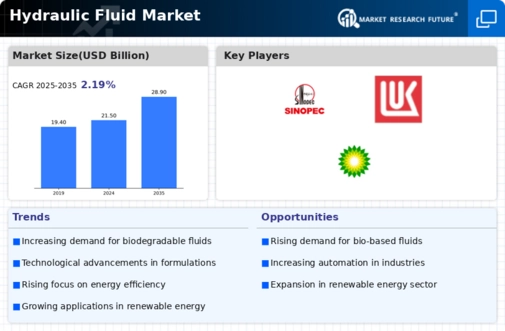Market Share
Hydraulic Fluid Market Share Analysis
Market share positioning strategies in the Hydraulic Fluid Market are critical for companies to gain a competitive edge and solidify their presence in the industry. These strategies encompass various approaches aimed at capturing a larger portion of the market and enhancing brand recognition. One common strategy involves differentiation, where companies offer unique hydraulic fluid formulations or specialized products tailored to specific industry needs. By providing distinct features or benefits, such as improved performance in extreme conditions or environmental sustainability, companies can attract customers seeking solutions beyond basic hydraulic fluids.
However, it can also be designed to work with alternative water pumps to protect against the growth of microorganisms, corrosion, and rust. There are many uses for hydraulic fluid, for example, in garbage trucks, elevators, hydraulic brakes, and even power steering systems. How do you think the mechanical arm collects the trash and crushes it? Hydraulic fluid is indispensable for proper operation and helps components that operate under high pressure to function properly.
Another key strategy is pricing, where companies strategically set their prices to appeal to different market segments. This may involve offering premium products at higher prices to target customers who prioritize quality and performance, while also providing more affordable options to attract price-sensitive buyers. By diversifying their product range and pricing tiers, companies can effectively cater to a broader customer base and maximize their market penetration.
Furthermore, distribution plays a crucial role in market share positioning. Companies can expand their reach and accessibility by establishing strong distribution networks, partnering with distributors, or utilizing online platforms for direct sales. By ensuring convenient availability of their products across various channels, companies can increase their market share and capture demand in both traditional and emerging markets.
In addition to product differentiation, pricing, and distribution, effective marketing strategies are essential for enhancing market share positioning. This includes targeted advertising, brand promotion, and engagement with key stakeholders such as manufacturers, OEMs, and end-users. By effectively communicating the value proposition of their hydraulic fluids and building brand awareness, companies can influence purchasing decisions and gain a competitive advantage over rivals.
Moreover, innovation plays a vital role in market share positioning within the Hydraulic Fluid Market. Companies that invest in research and development to create advanced formulations, improve product performance, or enhance environmental sustainability can differentiate themselves and attract discerning customers. Innovation not only drives product differentiation but also reinforces brand reputation and customer loyalty, ultimately strengthening market share positioning in the long term.
Additionally, strategic partnerships and collaborations can provide opportunities for companies to expand their market share and leverage complementary strengths. By partnering with industry leaders, suppliers, or technology providers, companies can access new markets, distribution channels, or technologies that enhance their competitive position. Strategic alliances can also facilitate knowledge sharing, resource pooling, and synergies that drive innovation and growth within the Hydraulic Fluid Market.
Furthermore, customer-centric approaches are essential for maintaining and growing market share in the Hydraulic Fluid Market. Companies that prioritize customer satisfaction, offer exceptional service, and address evolving needs and preferences can build strong relationships and loyalty among their customer base. By consistently delivering value and exceeding customer expectations, companies can retain existing customers while attracting new ones, thereby solidifying their market share positioning over time.






Leave a Comment